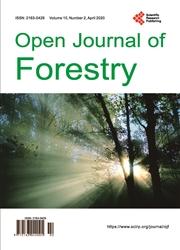Land Use/Land Cover Changes of Ago-Owu Forest Reserve, Osun State, Nigeria Using Remote Sensing Techniques
引用次数: 7
Abstract
Remote sensing (RS) and GIS are important methods for land use assessment and land cover transition. In this study, land use/land cover changes in the Ago-Owu Forest Reserve, Osun State, Nigeria have been assessed. Landsat 5 TM, Landsat 7 ETM+ and Landsat 8 OLI were acquired for 1986, 2002 and 2017 respectively. The three scenes corresponded to path 190 and row 055 of WRS-2 (Worldwide Reference System). The processing of the imagery was preceded by the clipping of the study area from the satellite image. The boundary of the reserve was carefully digitized and used to clip the imagery to produce an image map of the forest reserve. Using the supervised image classification procedure, training sites were used to produce land use/land cover maps. The same classification scheme was used for the 1986, 2002 and 2017 images to facilitate the detection of change. The differences in the area covered by the different polygons between the three sets of images were measured in km2. The results show that during 1986 and 2017, there is a dramatic increase of build-up areas with a change of 55.65 km2 and sparse vegetation (farmland and grassland) with a change of 53.97 km2, while a dramatic decrease of dense vegetation (forest areas) with a change of 109.61 km2. The consequence of these results is that over the years, the population of people living in the forest reserve has increased and many of them are engaged in farming, leading to an increase in farmland. In addition, logging activities continued unabated in the forest reserve, as demonstrated by a sharp increase in the deforested area within the reserve. The maps produced in this study will serve as a planning tool for the Osun State Forestry Department to plan reforestation activities for the forest reserve.基于遥感技术的尼日利亚奥孙州Ago-Owu森林保护区土地利用/覆被变化
遥感(RS)和地理信息系统(GIS)是土地利用评价和土地覆被转换的重要方法。本研究对尼日利亚奥孙州Ago-Owu森林保护区的土地利用/土地覆盖变化进行了评估。Landsat 5 TM、Landsat 7 ETM+和Landsat 8 OLI分别于1986年、2002年和2017年获得。这三个场景对应于WRS-2(全球参考系统)路径190和第055行。在对图像进行处理之前,先从卫星图像中截取研究区域。保护区的边界被仔细地数字化,并用于剪辑图像,以产生森林保护区的图像地图。使用监督图像分类程序,训练地点被用来制作土地利用/土地覆盖地图。为了便于检测变化,1986年、2002年和2017年的图像使用了相同的分类方案。以km2为单位测量了三组图像之间不同多边形覆盖面积的差异。结果表明:1986年至2017年,建成区面积急剧增加,变化幅度为55.65 km2,稀疏植被(农田和草地)面积急剧增加,变化幅度为53.97 km2,而茂密植被(森林)面积急剧减少,变化幅度为109.61 km2;这些结果的后果是,多年来,居住在森林保护区的人口增加了,其中许多人从事农业,导致农田面积增加。此外,森林保护区内的伐木活动继续有增无减,保护区内被砍伐的森林面积急剧增加就证明了这一点。在这项研究中制作的地图将作为奥孙州林业部规划森林保护区再造林活动的规划工具。
本文章由计算机程序翻译,如有差异,请以英文原文为准。
求助全文
约1分钟内获得全文
求助全文

 求助内容:
求助内容: 应助结果提醒方式:
应助结果提醒方式:


